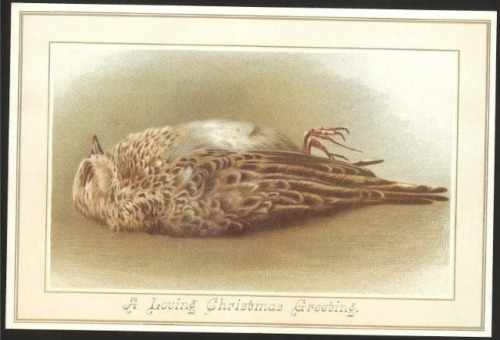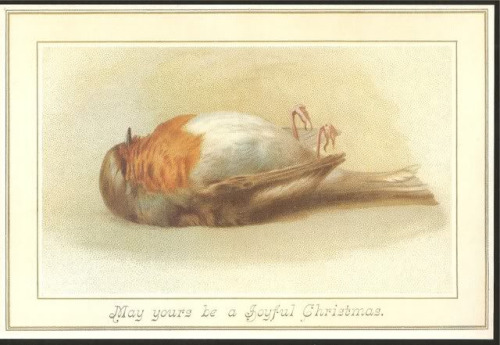
These cards get the most disbelief and shock of any I’ve found. So, first, let me answer the usual questions:
1) Are they real? Yes, very much so.
2) Was this a one-off thing? No, they were a trend. There are different styles and qualities, so it wasn’t a single set or collection that were just oddball.
3) So…what the hell?
I’m still not completely satisfied with the explanations I’ve found, although I have a good guess, which I’ll get to in a minute. But most speculation follows the lead of the book where I first found them: John Grossman’s Christmas Curiosities: Odd, Dark, and Forgotten Christmas. Here’s Grossman’s take:

A dead European robin frozen from the cold was bound to elicit Victorian sympathy and pity and may reference common stories of poor children freezing to death at Christmas. The 1880s card may have invoked one’s own good fortune and that of the card’s recipient during the holidays. (214)
It’s certainly possible that the Victorian love of sentimentalism was being exploited with these things. And it’s true that it wasn’t just holiday cards that got the dead bird treament. A similar image was used with a general well wishing card:

“Hope you aren’t dead like this guy” seems like a reasonable enough sentiment. But what bugs me is where there are so many examples of these with the holidays. There’s not much in the text to explain it: “May yours be a Joyful Christmas” and “A Loving Christmas Greeting” don’t even seem to acknowledge the befowled fowls.
So I followed what little leads I could find. Grossman points out that two of the birds, the robin and the wren, were sacred to different degrees in Anglo and Irish folklore, but he seems wrong by suggesting that they weren’t meant to be harmed. In fact, there’s an old Celtic holiday tradition (or ritual), still celebrated in a few small corners of Ireland, that begins by killing a bird: Wren Day. Irishfestivals.net explains it this way:
In Ireland, St. Stephen’s Day [the day after Christmas] is the day for “Hunting the Wren” or “Going on the Wren.” Originally, groups of small boys would hunt for a wren, and then chase the bird until they either have caught it or it has died from exhaustion. The dead bird was tied to the top of a pole or holly bush, which was decorated with ribbons or colored paper.
It even points to an tradition of seeing the robin as a symbol of the new year while the wren was the symbol of the old year. That certainly fits with Grossman’s robin and wren images (although it doesn’t seem quite right to kill off the new year’s symbol before it had a chance to start).
You can read a bit more background on the holiday here, even hearing a song supposedly sung as the “Wren Boys” wandered from house to house with the dead bird on a pole, doing a bit of wassail-ing and partying along the way.
So if that’s the connection, then the cards are reminders of local traditions that are both part of Christmas and New Year celebrations. And they’re more symbolic than sympathetic, which seems to make more sense to me than a random card that doesn’t even acknowledge that they’re supposed to be pulling on heart strings. A common analogue might be turkeys on Thanksgiving cards — we know we’re going to kill and eat the things, but we show images of them fully alive and thriving. We don’t have to explain the image because we know the connections. The dead bird, however morbid, likely held some common cultural currency.
Of course, there’s a simpler answer, too: maybe they just had a screwed up sense of humor and loved the incongruity as much as I do.



10 comments